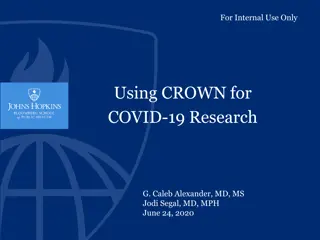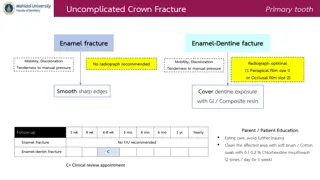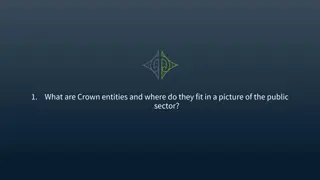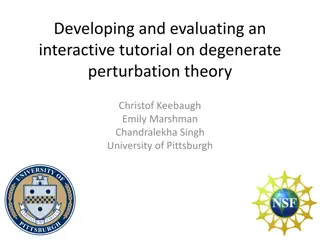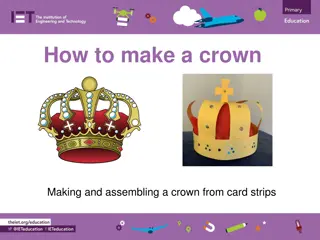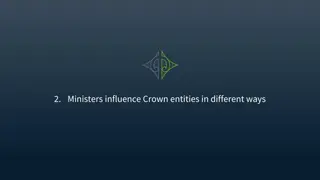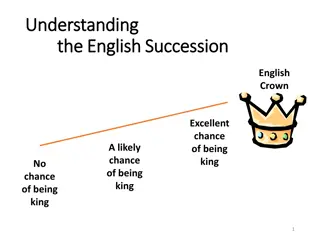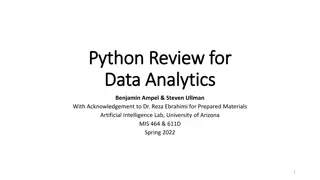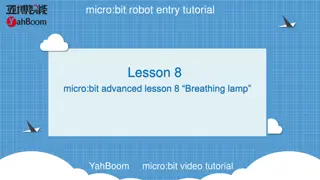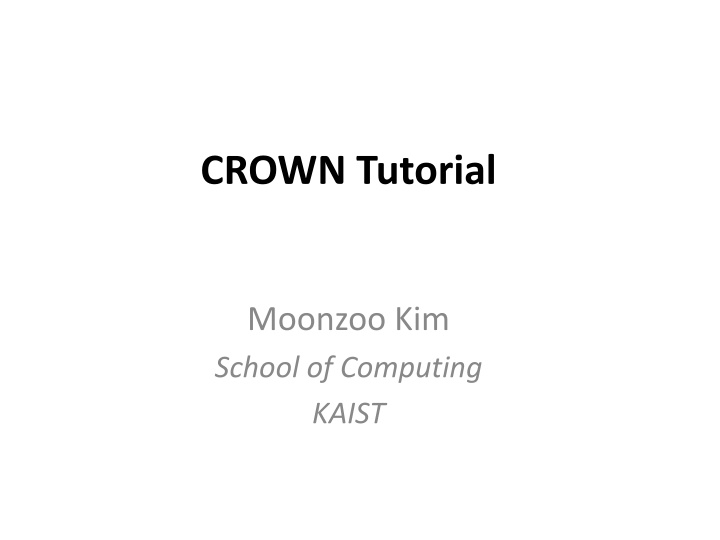
CROWN Tutorial by Moonzoo Kim at KAIST
Discover CROWN, a concolic testing tool for C programs developed by Moonzoo Kim at the School of Computing, KAIST. Learn how CROWN systematically explores execution paths, extracts symbolic path formulas, and generates test inputs with the help of a symbolic path formula solver. Explore the instrumented C code and commands of CROWN to enhance your understanding of this powerful automated testing tool.
Download Presentation

Please find below an Image/Link to download the presentation.
The content on the website is provided AS IS for your information and personal use only. It may not be sold, licensed, or shared on other websites without obtaining consent from the author. If you encounter any issues during the download, it is possible that the publisher has removed the file from their server.
You are allowed to download the files provided on this website for personal or commercial use, subject to the condition that they are used lawfully. All files are the property of their respective owners.
The content on the website is provided AS IS for your information and personal use only. It may not be sold, licensed, or shared on other websites without obtaining consent from the author.
E N D
Presentation Transcript
CROWN Tutorial Moonzoo Kim School of Computing KAIST
CROWN CROWN is a concolic testing tool for C programs Explore all possible execution paths of a target systematically To extract symbolic path formulas from concrete executions, it inserts probes into target C code CROWN s instrumentation is implemented as a module of CIL (C Intermetiate Language) written in Ocaml CIL provides convenient features to analyze/modify target C code Generate test inputs automatically by solving symbolic path formulas by using a SMT solver CROWN is the core engine of the commercial automated testing tool CROWN 2.0 https://www.vpluslab.kr/crown2 Moonzoo Kim SWTV Group 2/20
Overview of CROWN code C source code CIL EXT cil/src/ext/CROWNInstrument.ml src/libCROWN/CROWN.cc src/base/symbolic_interpreter.cc src/base/symbolic_execution.cc src/base/symbolic_expression.cc src/base/symbolic_path.cc src/base/symbolic_predicate.cc Instrumented C code CROWN SymEx library Inst. binary program Legend Target program Forking a new process SymEx path formula External tool a)input b)type CROWN src/run_CROWN/run_CROWN.cc src/run_CROWN/concolic_search.cc src/base/yices_solver.cc src/base/symbolic_execution.cc src/base/symbolic_expression.cc src/base/symbolic_path.cc src/base/symbolic_predicate.cc src/base/basic_types.cc Modified sym. path formula SMT Solver run_CROWN next input (i.e. solution of ) Moonzoo Kim SWTV Group 3/20
Instrumented C Code #line 10 { /* Creates symbolic expression a==b */ __CrownLoad(36, (unsigned long )(& a), (long long )a); __CrownLoad(35, (unsigned long )(& b), (long long )b); __CrownApply2(34, 12, (long long )(a == b)); if (a == b) { __CrownBranch(37, 11, 1); //extern void __CrownBranch(int id , int bid , unsigned char b ) __CrownLoad(41, (unsigned long )(& match), (long long )match); __CrownLoad(40, (unsigned long )0, (long long )1); __CrownApply2(39, 0, (long long )(match + 1)); __CrownStore(42, (unsigned long )(& match)); match ++; Control dependency v.s. Data dependency - match has control dependency on a and b - match does not have data dependency on a and b } else { __CrownBranch(38, 12, 0); } } Moonzoo Kim SWTV Group
CROWN Commands crownc <filename>.c Output <filename>.cil.c branches // lists of paired branches <filename> // executable file run_crown ./filename <n> -[dfs|cfg|random|random_input|hybrid] [-TCDIR <tc_folder>] [-INIT_TC] <n>: # of iterations/testings Concolic search strategies dfs: depth first search rev-dfs : reverse depth first search cfg: uncovered branch first random: negated branch is randomly selected random_input: pure random input hybrid: combination of dfs and random -INIT_TC: to use input file in a target directory as an initial test case if input file does not exist, run_CROWN terminates with an error message Output (updating at each iteration) input: containing concrete types and values of symbolic variables szd_execution: symbolic execution path coverage: coverage achieved so far A test case file in <tc_folder> if TCDIR option is given // instrumented C file Moonzoo Kim SWTV Group
4 Main Tasks of Human Engineers 1. Adding proper assert() statements W/o assert(), only runtime crash can be detected 2. Selection of symbolic variables in a target program Identify which parts of a target program are most important 3. Construction of symbolic external environment To reduce false alarms and detect real bugs 4. Performance tuning and debugging To obtain better concolic testing results 6/47
Supported Symbolic Data-types #define SYM_unsigned_char(x) __CrownUChar(&x) #define SYM_unsigned_short(x) __CrownUShort(&x) #define SYM_unsigned_int(x) __CrownUInt(&x) #define SYM_char(x) __CrownChar(&x) #define SYM_short(x) __CrownShort(&x) #define SYM_int(x) __CrownInt(&x) #define SYM_float(x) __CrownFloat(&x) #define SYM_double(x) __CrownDouble(&x) Moonzoo Kim SWTV Group
Symbolic Variable w/ Initial Value SYM_unsigned_char_init (x, 7) SYM_unsigned_short_init(x, 7) SYM_unsigned_int(x, 7) SYM_char_init(x, 7) SYM_short(x, 7) SYM_int(x, 7) SYM_float(x, 7.0) SYM_double(x, 7.0) #include<crown.h> int main() { int x; SYM_int_init(x, 7); printf("x=%d\n", x); if ( x > 10) printf("x>10\n"); else printf("x<=10\n"); } Moonzoo Kim SWTV Group
Symbolic Assumption You can describe symbolic assumption using SYM_assume(exp) exp is guaranteed to be true right after SYM_assume(exp) similar to __CPROVER_assume(exp)in CBMC Ex. #include <crown.h> #include <stdio.h> #include <assert.h> void main() { int x, y; SYM_int(x); SYM_int(y); SYM_assume( x + y > 10); printf("x=%d, y=%d\n", x, y); assert( x + y > 10); } Moonzoo Kim SWTV Group 9/10
Software Testing a craftsman s approach 2nded by P.C.Jorgensen (no check for positive inputs) Moonzoo Kim SWTV Group
#include <stdlib.h> #include <stdio.h> #include <string.h> #include <crown.h> // Return value: // 0: Equilateral, 1:Isosceles, // 2: Not a triangle, 3:Scalene int triangle(int a, int b, int c) { int result=-1, match=0; #define CROWN int triangle(int, int, int); if(a==b) match=match+1; if(a==c) match=match+2; if(b==c) match=match+3; int main() { int a,b,c, result; if(match==0) { if( a+b <= c) result=2; else if( b+c <= a) result=2; else if(a+c <= b) result =2; else result=3; } else { if(match == 1) { if(a+b <= c) result =2; else result=1; } else { if(match ==2) { if(a+c <=b) result = 2; else result=1; } else { if(match==3) { if(b+c <= a) result=2; else result=1; } else result = 0; } }} #ifdef CROWN SYM_int(a); SYM_int(b); SYM_int(c); //filtering out invalid inputs SYM_assume(a>0 && b>0 && c>0); printf("a,b,c = %d,%d,%d\n",a,b,c); #else printf("Please type 3 integers:\n"); scanf("%d,%d,%d",&a,&b,&c); #endif result=triangle(a,b,c); char triangle_type[20]; switch(result) { case 0: strcpy(triangle_type, "an equilateral"); break; case 1: strcpy(triangle_type, "an isoscele"); break; case 2: strcpy(triangle_type, "not a triangle"); break; case 3: strcpy(triangle_type, "a scalene"); break; defaults: break; } printf( Type: %s.\n",triangle_type); return result; } Moonzoo Kim SWTV Group }
Compile/Instrumentation Snapshot verifier3:~/crown/triangle$ crownc triangle.c Complied with FP option Read 42 branches. Read 78 nodes. Wrote 48 branch edges. >>> cilly command: /usr/bin/../cil/bin/cilly triangle.c -o t riangle --save-temps --doCrownInstrument -I/usr/bin /../include -L/usr/bin/../lib -L/usr/bin/../lib -lcrown-f p -lstdc++ -g -lrt -Wno-attributes -lpthread gcc -D_GNUCC -E -I/usr/bin/../include -g -DCIL=1 triangle .c -o ./triangle.i /usr/cil/bin/cilly.native --out ./triangle.cil.c --doCrownInst rument ./triangle.i triangle.c:34: Warning: Body of function main falls-throu gh. Adding a return statement gcc -D_GNUCC -E -I/usr/bin/../include -g ./triangle.cil.c -o ./triangle.cil.i gcc -D_GNUCC -c -I/usr/bin/../include -g -g -Wno-attribut es -o ./triangle.o ./triangle.cil.i gcc -D_GNUCC -o triangle -I/usr/bin/../include -g -g -Wno -attributes ./triangle.o -L/usr/bin/../lib -L/usr/bin/../li b -lcrown-fp -lstdc++ -g -lrt -lpthread >>> Check cilly >>> cilly - success! >>> Find the file(triangle) >>> start: 2022-11-17 12:02:26 >>> end: 2022-11-17 12:02:26 >>> gcc command(sanitizer none): gcc -o triangle_replay triangle.c -I/usr/bin/../include -L/usr/bin/../lib -lcrow n-replay --coverage -Wno-attributes -lpthread >>> Check gcc >>> gcc - success >>> Find the file(triangle_replay) >>> start: 2022-11-17 12:02:26 >>> end: 2022-11-17 12:02:26 verifier3:~/crown/triangle$ l triangle.c triangle.i triangle.cil.c triangle.cil.i triangle.gcno triangle.o triangle triangle_replay branches cfg_branches funcount cfg cfg_func_map idcount stmtcount
Execution Snapshot (1/2) $ run_crown ./triangle 50 -dfs -TCDIR tcs ------------------------- program command is triangle ### SYM_assume(a>0 && b>0 && c>0) is violated at Line 17 (main in triangle.c) ### ... ------------------------- program command is triangle a,b,c = 1,1,1 This triangle is an equilateral. Iteration 1 (0s, 0s, 0.018s): covered 11 branches [2 reach funs, 42 reach branches] ------------------------- a,b,c = 1610612736,1610612736,536870912 This triangle is not a triangle. Iteration 2 (1s, 1s, 0.043s): covered 18 branches [2 reach funs, 42 reach branches] ------------------------- a,b,c = 2,2,1 This triangle is an isoscele. Iteration 3 (1s, 0s, 0.050s): covered 20 branches [2 reach funs, 42 reach branches] ------------------------- a,b,c = 1610612736,536870912,1 This triangle is not a triangle. Iteration 4 (1s, 0s, 0.060s): covered 23 branches [2 reach funs, 42 reach branches] ------------------------- a,b,c = 272629760,1346371584,809500672 This triangle is not a triangle. Iteration 5 (1s, 0s, 0.067s): covered 25 branches [2 reach funs, 42 reach branches] ------------------------- a,b,c = 1108719680,34977856,1108457536 This triangle is not a triangle. Iteration 6 (1s, 0s, 0.074s): covered 27 branches [2 reach funs, 42 reach branches] ------------------------- a,b,c = 427818799,427818767,377487598 This triangle is a scalene. Iteration 7 (1s, 0s, 0.085s): covered 30 branches [2 reach funs, 42 reach branches] ------------------------- a,b,c = 1610612736,536870912,536870912 This triangle is not a triangle. Iteration 8 (1s, 0s, 0.091s): covered 32 branches [2 reach funs, 42 reach branches] ------------------------- a,b,c = 1,2,2 This triangle is an isoscele. Iteration 9 (1s, 0s, 0.098s): covered 33 branches [2 reach funs, 42 reach branches] ------------------------- a,b,c = 1610612736,536870912,1610612736 This triangle is not a triangle. Iteration 10 (1s, 0s, 0.104s): covered 35 branches [2 reach funs, 42 reach branches] ------------------------- a,b,c = 2,1,2 This triangle is an isoscele. Iteration 11 (1s, 0s, 0.111s): covered 36 branches [2 reach funs, 42 reach branches]
Concolic Testing the Triangle Program Test case (a,b,c) (SPF) Input Executed symbolic path formula Modified symbolic path formula ' Solution for the modified SPF Unsat 1,1,2 a=b a=c b=c a=b a=c b c a=b a c TC1 1,1,1 a=b a c b c a+b c a=b a c b c a+b > c 2,2,3 a=b a c b c a+b >c a=b a c b=c a b a b a=c b c a+c>b a b a=c b c a+c b TC2 1,1,2 TC3 2,2,3 Unsat 2,1,2 2,5,2 TC4 2,1,2 a=b a b a c a=c a=c b=c b c b c b c b=c TC1 a+c >b TC4 a+b c TC2 a+b >c TC3 Moonzoo Kim SWTV Group
Execution Snapshot (2/2) $ cat coverage 6 /*covered branch IDs*/ 7 8 21 22 24 25 27 28 30 48 49 51 52 54 55 57 58 59 60 61 62 ... $ l tcs input.1 ... input.11 type.1 ... type.11 $ cat branches 1 8 /* branch IDs */ 6 11 7 10 8 9 13 14 21 22 24 25 27 28 30 31 2 13 48 49 51 52 54 55 57 64 58 59 60 61 62 63 65 68 66 67 69 72 70 71 73 76 74 75 ...$ print_execution Symbolic variables & input values (a_1 = 2) [ Line: 14, File: triangle.c ] (b_1 = 1) [ Line: 14, File: triangle.c ] (c_1 = 2) [ Line: 14, File: triangle.c ] Symbolic path formula (a_1 > 0) [ Line: 17, File: triangle.c ] (b_1 > 0) [ Line: 17, File: triangle.c ] (c_1 > 0) [ Line: 17, File: triangle.c ] ! (a_1 == b_1) [ Line: 43, File: triangle.c ] (a_1 == c_1) [ Line: 44, File: triangle.c ] ! (b_1 == c_1) [ Line: 45, File: triangle.c ] ! ((a_1 + c_1) <= b_1) [ Line: 58, File: triangle.c ] Sequence of reached branch ids -1 [main enters] 6 [ Line: 17, File: triangle.cil.c ] 7 [ Line: 17, File: triangle.cil.c ] 8 [ Line: 17, File: triangle.cil.c ] -1 [triangle enters] 49 [ Line: 43, File: triangle.cil.c ] 51 [ Line: 44, File: triangle.cil.c ] 55 [ Line: 45, File: triangle.cil.c ] 64 [ Line: 47, File: triangle.cil.c ] 68 [ Line: 53, File: triangle.cil.c ] 69 [ Line: 57, File: triangle.cil.c ] 71 [ Line: 58, File: triangle.cil.c ] -2 [triangle exits] 22 [ Line: 28, File: triangle.cil.c ] 24 [ Line: 29, File: triangle.cil.c ] -2 [main exits]
Symbolic Debugging [1/2] 1. Select [TCDIR]/input.[n] whose symbolic path formula you would like to know 2. Copy [TCDIR]/input.[n] to a target directory with a name input Also copy type.[n] 3. Run an instrumented executable target program Note that an instrumented executable target program reads input file w/ type as an initial test case Ex. ./triable 4. See symbolic information of input.[n] by using print_execution Moonzoo Kim SWTV Group 16/10
Symbolic Debugging (2/2) ...$ run_crown ./triange... ... ----------------- program command is triangle a,b,c = 1,1,1 This triangle is an equilateral. Iteration 1 (0s, 0s, 0.018s): covered 11 branches [2 reach funs, 42 reach branches] ------------------ ... ...$ cp tcs/input.1 input ...$ cp tcs/type.1 type ...$ ./triangle a,b,c = 1,1,1 This triangle is an equilateral. $ print_execution Symbolic variables & input values (a_1 = 1) [ Line: 7, File: triangle-crown.c ] (b_1 = 1) [ Line: 7, File: triangle-crown.c ] (c_1 = 1) [ Line: 7, File: triangle-crown.c ] Symbolic path formula (a_1 > 0) [ Line: 15, File: triangle-crown.c ] (b_1 > 0) [ Line: 15, File: triangle-crown.c ] (c_1 > 0) [ Line: 15, File: triangle-crown.c ] (a_1 == b_1) [ Line: 21, File: triangle-crown.c ] (a_1 == c_1) [ Line: 22, File: triangle-crown.c ] (b_1 == c_1) [ Line: 23, File: triangle-crown.c ] Sequence of reached branch ids -1 [main enters] 6 [ Line: 15, File: triangle-cro ] 7 [ Line: 15, File: triangle-cro ] 8 [ Line: 15, File: triangle-cro ] 20 [ Line: 21, File: triangle-cro ] 23 [ Line: 22, File: triangle-cro ] 26 [ Line: 23, File: triangle-cro ] 36 [ Line: 24, File: triangle-cro ] 40 [ Line: 30, File: triangle-cro ] 44 [ Line: 34, File: triangle-cro ] 48 [ Line: 38, File: triangle-cro ] 51 [ Line: 46, File: triangle-cro ] -2 [main exits]
Instrumented C Code #line 10 { /* Creates symbolic expression a==b */ __CrownLoad(36, (unsigned long )(& a), (long long )a); __CrownLoad(35, (unsigned long )(& b), (long long )b); __CrownApply2(34, 12, (long long )(a == b)); if (a == b) { __CrownBranch(37, 11, 1); //extern void __CrownBranch(int id , int bid , unsigned char b ) __CrownLoad(41, (unsigned long )(& match), (long long )match); __CrownLoad(40, (unsigned long )0, (long long )1); __CrownApply2(39, 0, (long long )(match + 1)); __CrownStore(42, (unsigned long )(& match)); match ++; Control dependency v.s. Data dependency - match has control dependency on a and b - match does not have data dependency on a and b } else { __CrownBranch(38, 12, 0); } } Moonzoo Kim SWTV Group
Decision/Condition Coverage Analysis by CROWN 1 int main(){ 2 int A, B, C, D; 3 if (A && B || C && D){ 4 printf("Yes\n"); 5 }else{ 6 printf("No\n"); 7 } 8 } 1 if (A != 0) { 2 __CrownBranch(5, 2, 1); 3 if (B != 0) { 4 __CrownBranch(10, 3, 1); 5 printf("Yes\n"); 6 } else { 7 __CrownBranch(11, 4, 0); 8 goto _L; 9 } 10 } else { 11 __CrownBranch(6, 5, 0); 12 _L: /* CIL Label */ 13 if (C != 0) { 14 __CrownBranch(16, 6, 1); 15 if (D != 0) { 16 __CrownBranch(21, 7, 1); 17 printf("Yes\n"); 18 } else { 19 __CrownBranch(22, 8, 0); 20 printf("No\n"); 21 } 22 } else { 23 __CrownBranch(17, 9, 0); 24 printf("No\n"); 25 } 26 } A == T A == T && B == T A == T && B != T CROWN transforms a compound predicate into atomic ones with nested conditional statements CROWN consider all possible cases with short-circuit Thus, branch coverage reported by CROWN might be lower than actual branch coverage A != TRUE (A != T || A == T && B != T) && C == T (A != T || A == T && B != T) && C == T && D == T (A != T || A == T && B != T) && C == T && D != T (A != T || A == T && B != T) && C != T 19/13
Measure Branch Coverage w/ TCs generated by crown_replay $ cp tcs/input.4 input $ cp tcs/type.4 type $ crown_replay Usage : crown_replay <PROGRAM_CMD> [OPTION]... Options: -d <DIR> Use test inputs in the directory <DIR>. (Default : testdir) -s <ITER_START> Start the iteration from the <ITER_START>th test. (Default : 1) -e <ITER_END> End the iteration to the <ITER_END>th test. (Default : # of test inputs in <DIR>) $ ./triangle_replay a,b,c = 2,1,2 This triangle is an isoscele. $ gcov -b -f triangle Function 'triangle' Lines executed:61.90% of 21 Branches executed:61.54% of 26 Taken at least once:42.31% of 26 No calls Function 'main' Lines executed:81.82% of 11 Branches executed:84.62% of 13 Taken at least once:38.46% of 13 Calls executed:54.55% of 11 crownc generates <target>_replay which is an original target program (i.e., conditional stmts not transformed, symbolic execution not extracted) that can read TCs generated by CROWN Ex> triangle_replay <target>_replay reads input file in the same directory to replay crown_replay replays <target>_replay to measure branch coverage of the original target program with TCs in <DIR> generated by CROWN File 'triangle.c' Lines executed:68.75% of 32 Branches executed:69.23% of 39 Taken at least once:41.03% of 39 Calls executed:54.55% of 11 $ crown_replay ./triangle_replay -d tcs -s 5 -e 7 a,b,c = 1610612736,536870912,536870912 This triangle is not a triangle. Iteration 5 ------------------------- a,b,c = 1,2,2 This triangle is an isoscele. Iteration 6





